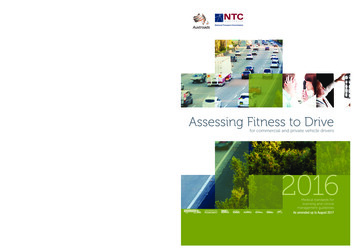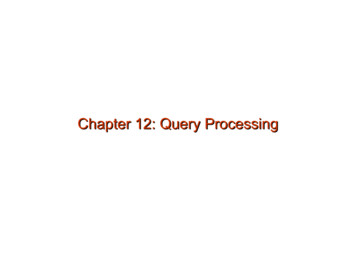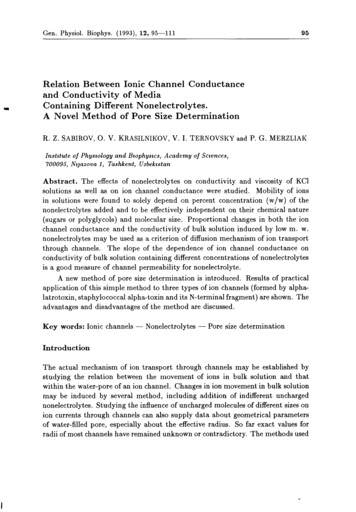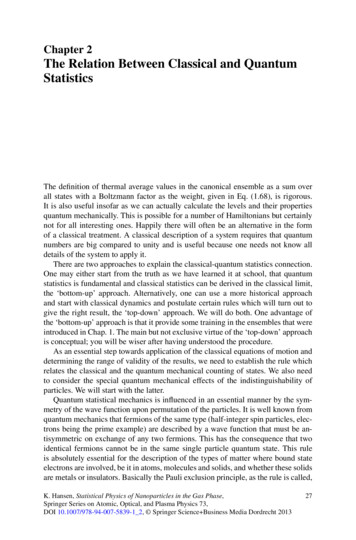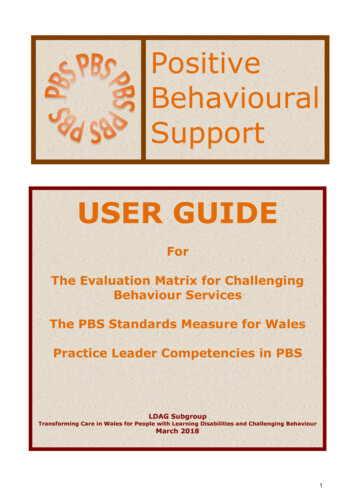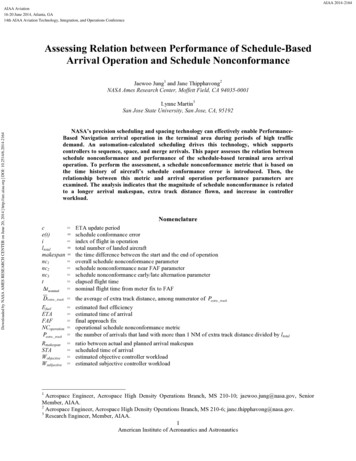
Transcription
AIAA 2014-2164AIAA Aviation16-20 June 2014, Atlanta, GA14th AIAA Aviation Technology, Integration, and Operations ConferenceAssessing Relation between Performance of Schedule-BasedArrival Operation and Schedule NonconformanceJaewoo Jung1 and Jane Thipphavong2NASA Ames Research Center, Moffett Field, CA 94035-0001Downloaded by NASA AMES RESEARCH CENTER on June 20, 2014 http://arc.aiaa.org DOI: 10.2514/6.2014-2164Lynne Martin3San Jose State University, San Jose, CA, 95192NASA’s precision scheduling and spacing technology can effectively enable PerformanceBased Navigation arrival operation in the terminal area during periods of high trafficdemand. An automation-calculated scheduling drives this technology, which supportscontrollers to sequence, space, and merge arrivals. This paper assesses the relation betweenschedule nonconformance and performance of the schedule-based terminal area arrivaloperation. To perform the assessment, a schedule nonconformance metric that is based onthe time history of aircraft’s schedule conformance error is introduced. Then, therelationship between this metric and arrival operation performance parameters areexamined. The analysis indicates that the magnitude of schedule nonconformance is relatedto a longer arrival makespan, extra track distance flown, and increase in nnc1nc2nc3tΔtnominal D extra trackEfuelETAFAFNCoperationPextra track the average of extra track distance, among numerator of Pextra track estimated fuel efficiencyestimated time of arrivalfinal approach fixoperational schedule nonconformance metricthe number of arrivals that land with more than 1 NM of extra track distance divided by ltotalRmakespanSTAWobjectiveWsubjective ratio between actual and planned arrival makespanscheduled time of arrivalestimated objective controller workloadestimated subjective controller workload1ETA update periodschedule conformance errorindex of flight in operationtotal number of landed aircraftthe time difference between the start and the end of operationoverall schedule nonconformance parameterschedule nonconformance near FAF parameterschedule nonconformance early/late alternation parameterelapsed flight timenominal flight time from meter fix to FAFAerospace Engineer, Aerospace High Density Operations Branch, MS 210-10; jaewoo.jung@nasa.gov, SeniorMember, AIAA.2Aerospace Engineer, Aerospace High Density Operations Branch, MS 210-6; jane.thipphavong@nasa.gov.3Research Engineer, Member, AIAA.1American Institute of Aeronautics and Astronautics
Downloaded by NASA AMES RESEARCH CENTER on June 20, 2014 http://arc.aiaa.org DOI: 10.2514/6.2014-2164NI. IntroductionASA has been developing a precision scheduling and spacing system that is capable of meeting increaseddemand while supporting the use of fuel-efficient arrival procedures.1,2 This system, which integrates anenhancement to Time Based Flow Management (TBFM) and controller advisory tools, has been extensivelyevaluated with a series of human-in-the-loop (HITL) air traffic simulations. Results indicate up to a 10% increase inairport throughput during capacity constrained periods, while maintaining fuel-efficient aircraft descent profiles withreduced subjective controller workload.3-5The FAA recognized that NASA’s precision scheduling and spacing system can enable consistent use ofPerformance-Based Navigation (PBN) procedures in the terminal area, which is a key element of the NextGeneration Air Transportation System.6,7 Consequently, NASA applied its technology to develop the TerminalSequencing and Spacing (TSS) tool, and carried out a technology transfer to the FAA in October 2013.8 As a part ofthis effort, NASA, the FAA, and MITRE’s Center for Advanced Aviation System Development (CAASD)conducted a joint HITL simulation in 2013 to assess the effectiveness of the TSS tool in enabling PBN operationsduring periods of high traffic demand. 9The joint HITL simulation compared PBN arrival operations with and without the use of TSS tool, which hastwo main components: 1) a scheduler that de-conflicts merging arrivals in the terminal area by computingappropriate arrival times to the runway threshold and upstream merge points,1 and 2) a set of Controller-ManagedSpacing (CMS) decision support tools to efficiently assist schedule adherence.2 The simulation had PBN routes thatconnected Standard Terminal Arrival Routes (STARs) to the runway or a fix near the runway. Some of the PBNroutes contained downwind, base, and final legs that are similar to conventional traffic patterns, whereas othersincluded radius-to-fix (RF) turns that shortened the downwind leg. Advanced navigation equipage was required tofly the latter routes. The simulation successfully demonstrated the effectiveness of the TSS tool in enabling PBNoperations with high density traffic.10 When the TSS tool was used, merging arrivals with different approachprocedures was more effective, flight path predictability improved, and air traffic controller participants reportedreduced workload.11Previous studies so far have evaluated the TSS tool assuming arrival schedule conformance with a certain levelof precision. This paper investigates the effect of schedule nonconformance on terminal area arrival operation. Aschedule nonconformance metric is introduced, and then used to examine its influence on performance parametersfor arrival operations. Data from the 2013 joint HITL simulation are used.The paper is organized as follows. Section II provides more details on the TSS tool evaluated in the 2013 jointHITL simulation. Section III defines the schedule nonconformance metric. Section IV explores the relationsbetween the metric and several performance parameters of arrival operations. Section V concludes the paper with asummary of key findings.II. BackgroundA. Terminal Scheduling and Sequencing Tool1. Operational ConceptThe TSS tool extends the use of TBFM to include terminal metering capabilities, which generates an arrivalschedule that conditions the flow in the Air Route Traffic Control Center (Center) to facilitate sequencing andspacing in the Terminal Radar Approach Control (TRACON). The TSS tool’s operational concept focuses onarrivals prior to top-of-descent (TOD) about 150 NM from the TRACON boundary. Use of PBN arrival routes thatconnect STARs to the runway or a fix near the runway is assumed. PBN defines aircraft performance requirementsin terms of navigation specifications; Area Navigation (RNAV) and Required Navigation Performance (RNP).12RNP is a higher fidelity RNAV specification with the addition of an on-board performance monitoring and alertingsystem as part of the avionic functionality. In the TSS concept, the majority of aircraft are assumed RNAVequipped, with some having advanced RNP capabilities.The arrival schedule is broadcast to the Center and TRACON automation systems. To assist Center controllerswith metering operations, their radar displays show meter lists and delay countdown timers (DCTs) with a resolutionof tenths of minutes. TRACON controllers are presented with CMS advisory tools to assist schedule conformance.The following subsections describe the TSS tool’s two main components, the arrival scheduler and the CMS tools,in further detail.2American Institute of Aeronautics and Astronautics
Downloaded by NASA AMES RESEARCH CENTER on June 20, 2014 http://arc.aiaa.org DOI: 10.2514/6.2014-21642. Arrival SchedulerThe arrival scheduler is a ground-based strategic planning and tactical control arrival management system thatgenerates an arrival schedule as well as TRACON advisories for schedule conformance.1 This scheduler uses 4-Dtrajectory predictions to compute the arrival sequence, STA, and runway assignments. Runway assignments areselected to balance runway usage and minimize overall system delay.13,14 The arrival sequence and STAs arecomputed at meter fixes located near the TRACON boundary, metering points in the terminal area where arrivalflows merge, and the runway threshold. The STAs are designed to de-conflict arrivals at merge points and adhere toseparation requirements. Delays to meet the STAs are allocated along the arrival route such that arrivals are able toremain on their assigned PBN routes in the terminal area. These schedule settings are dependent on the airspacegeometry.3. Controller-Managed Spacing ToolsThe CMS tools provide controller display aids for sequencing, spacing, and merging in the TRACON. Figure 1shows the different types of CMS tools that can be displayed on the TRACON controller’s radar display. The CMStools provide a slot marker circle and the marker’s Indicated Airspeed (IAS), the aircraft’s IAS, runway assignment,sequence number, speed advisories, early/late (E/L) indicators, and timelines to assist metering operations in theterminal area.2,15 The circular slot marker provides a spatial reference for each aircraft. The slot marker traverses theaircraft’s STA trajectory, which considers the forecast wind field and published restrictions. To follow the slotmarker, a speed advisory is given to the next meter point along the arrival route. In cases where speed advisories arenot sufficient for the aircraft to absorb the delay needed to meet its STA, an E/L indicator is displayed. Timelines arealso available for the controller to quickly monitor arrival sequence, current demand loads, and delay value.B. HITL Simulation1. ObjectiveIn April 2013, the TSS tool was tested at the NASA Ames Research Center air traffic control (ATC) simulationfacility over a period of two weeks. The planning, coordination and execution of the simulation was a collaborativeeffort between NASA, the FAA, and MITRE CAASD. The main objective of this simulation was to evaluate theeffectiveness of the TSS tool in enabling PBN operations in scenario conditions with mixed RNAV/RNP equipage,realistic wind forecast errors, and heavy traffic.2. Simulation EnvironmentThe Multi-Aircraft Control System (MACS) was used to conduct the HITL simulations.16 MACS provides highfidelity operational radar display emulations for air traffic controllers as well as user interfaces and displays forconfederate pilots and experiment managers. MACS also has a dynamic real-time air traffic simulation capabilitydesigned to generate realistic aircraft trajectories and associated radar and ADS-B messages for aircraft in a3American Institute of Aeronautics and Astronautics
Downloaded by NASA AMES RESEARCH CENTER on June 20, 2014 http://arc.aiaa.org DOI: 10.2514/6.2014-2164simulated airspace environment. The TSS tool’s arrival scheduler received aircraft flight plan information and trackdata from MACS as input. The arrival schedule and TRACON advisories were then sent to MACS for the controllerdisplays. The CMS tools’ controller display aids were integrated with the MACS emulation of the TRACONcontroller display.3. AirspaceThe simulation airspace was Phoenix Sky Harbor International Airport (PHX) in the West Flow configuration,using runways 25L and 26. Simulated MACS aircraft flew Instrument Flight Rules (IFR), and independent runwayoperations were assumed. Figure 2 illustrates the RNAV/RNP Optimal Profile Descent (OPD) STARs and controllersector boundaries modeled in the simulation. Crossing restrictions were similar to those published in the FAATerminal Procedures Publication.17Albuquerque Center (ZAB) and Phoenix TRACON (P50) are primarily responsible for sequencing arrivals intoPHX. The simulation had four ZAB arrival sectors, one for each meter fix, and four P50 positions, where a Feederand Final pair controlled the North and South flows to each of the runways.Arrival routes were assigned based on equipage level. RNAV-equipped arrivals using the MAIER and GEELASTARs have published routes ending at the BELLY and GATWA waypoints. These arrivals remained on thedownwind leg until ATC clearance for the base leg turn, joining final near JAGAL or GIPSE. Some aircraft thathave advanced RNP equipage are capable of RF turns within 0.1 NM lateral accuracy. With this capability, RNPequipped arrivals were given the advantage of a shortened downwind route. Instead of joining the final by JAGALor GIPSE, they could be cleared for the RNP-Authorization Required (RNP-AR) instrument approach procedure thatintercepts the final 3-4 NM earlier.4. Air Traffic ControllersFour Center and four TRACON positions were staffed during the simulations. The Center controllers wereconfederates, and were recently retired from Los Angeles Center and ZAB. The TRACON controller participantsconsisted of one recently retired controller, and three currently active Certified Professional Controllers (CPCs) fromBoston, Phoenix and New York TRACONs. The Phoenix and Boston CPCs had no exposure to the TSS tool prior tothe simulations. The others had less than two weeks of experience.5. Scenarios and Test ConditionsTwo scenarios with different peak demand times, A and B, were used during data collection. Only PHX arrivalswere included. Both scenarios were designed to represent generalized scenarios with sustained, heavy traffic, havingdemand peaks similar to other busy national airports. These scenarios were designed to produce an average of 2minutes of scheduled delay in the Center, and 20-35 seconds in the TRACON.The test conditions varied the scenario, wind forecast, use of TSS tool, and set of controller participants. The4American Institute of Aeronautics and Astronautics
wind forecast used in the trajectory calculations either ‘matched’ the truth winds or were ‘mismatched,’ having aroot-mean-square difference of approximately 8.5 knots, and were consistent with realistic wind forecast errors.18 Inthe baseline conditions, the TSS tool was not used. Test conditions for each experiment run using the TSS tool areshown in Table 1.III.Schedule Nonconformance MetricDownloaded by NASA AMES RESEARCH CENTER on June 20, 2014 http://arc.aiaa.org DOI: 10.2514/6.2014-2164A. DesignA metric to measure schedule nonconformance, NC, is based on eacharrival aircraft’s schedule conformance error, e, the difference betweenSTA and ETA at a schedule point. For this paper, e at Final Approach Fix(FAF) is a function of elapsed flying time t from meter fix to the FAF.Equation (1) shows this e(t). STA is assumed to be constant.e(t) STAFAF ETA(t)FAF(1)Figure 3 shows an example of e(t) at the FAF of an arrival aircraft.When e(t), shown in bars, is greater than zero, the arrival aircraft is flyingearlier than scheduled, and less than zero later than scheduled. Wherease(t) equal to zero indicates the arrival is on schedule, gaps between e(t)bars in this figure should not be interpreted as such. The smaller gapsbetween bars are associated with the ETA update period, which matcheswith the TRACON radar update period of about 5 seconds. The largergaps are associated with unavailable ETAdata. ETAs do not update once theaircraft arrives at the FAF. Figure 3shows that the aircraft was about 35second early at meter fix, became late,then arrived at the FAF about 5 secondearly. The elapsed flight time from themeter fix to the FAF was about 13minutes.NC consists of three non-dimensionalparameters, nc1, nc2, and nc3, shown inEq. (2), (3), and (4). To nondimensionalize them, two additionalvalues are used: 1) c, the update period ofETA, and 2) Δtnominal , the nominal flighttime from the meter fix to the FAF.Δtnominal is approximated by thedifference in STAs at the meter fix andthe FAF, as shown in Eq. (5). Δtnominal isalso used to normalize the threeparameters among routes with differenttransition times.nc1 nc2 e(t) dt(2)Δtnominal c e(t) ΔttdtnominalΔtnominal c5American Institute of Aeronautics and Astronautics(3)
de(t)dtdtnc3 Δtnominal Downloaded by NASA AMES RESEARCH CENTER on June 20, 2014 http://arc.aiaa.org DOI: 10.2514/6.2014-2164Δtnominal STAFAF STAmeterFix(4)(5)Parameter nc1 is designed to assess overall schedule nonconformance as aircraft transit from the meter fix to theFAF. nc2 is designed to emphasize schedule nonconformance near the FAF, since the Final controllers tend to haveless airspace and speed range to reduce e, compared to the Feeder controllers. nc3 is designed to emphasizealternation between early and late nonconformance, since this behavior can cause inefficient energy management ofthe aircraft.To quantify the schedule nonconformance of all aircraft in an arrival operation, NCoperation, the three parameters,nc1 operation , nc2 operation , and nc3 operation are calculated as shown in Eq. (6), (7), and (8). NCoperation is defined as sumof these, as shown in Eq. (9). i is index of flights in the operation, and ltotal is the total number of landed flights.ltotal nc1 flight inc1 operation i 1ltotal(6)ltotal nc2 flight inc2 operation i 1ltotal(7)ltotal nc3 flight inc3 operation i 1ltotalNCoperation : nc1 operation nc2 operation nc2 operation(8)(9)B. Schedule Nonconformance of Arrival Operations in the HITL SimulationIn the HITL simulation, schedule-based arrival operations were conducted in 12 experiment runs, using the TSStool. On the average, 60 aircraft landed in a run. Table 1 lists traffic scenarios and wind conditions for these runs.Whereas two different traffic scenarios were used, upstream conditions to the TRACON controllers, such as averagetraffic delay in the Center and average delivery accuracy to meter fix, were similar. Also, all participants reportedthat the difference in wind conditions, ‘matched’ or ‘mismatched’, had a negligible impact.Figure 4 shows operational schedule nonconformance of the 12 runs. On the left plot, NCoperation of each run isshown, where nc1 operation , nc2 operation , nc3 operation are stacked in different shades of grey. A boxplot of NCoperation isshown on the right, with bottom, middle, and top of the box indicating 25th, 50th and 75th percentiles. Whiskers cover99-percentile range, and the cross indicates an outlier, which is run 12. Variation in schedule nonconformanceamong the 12 operations is indicated in Fig. 4. The relation between this variation and operational performance isexamined in the following section. Since the majority of the variation shown in Fig. 4 is captured by nc1 operation ,relative significance of nc2 operation and nc3 operation will be examined in future work, in presence of operationaldisturbances such as an unscheduled medevac arrival.IV.Schedule Nonconformance and Performance of Arrival OperationA. Quantifying PerformancePerformance of an arrival operation is quantified using parameters that characterize the operation’s timeefficiency, lateral route efficiency, fuel efficiency, and controller workload. The following subsections describethese parameters, and Table 2 tabulates their values for the 12 operations. NCoperation of corresponding operations arealso included in the table.6American Institute of Aeronautics and Astronautics
Downloaded by NASA AMES RESEARCH CENTER on June 20, 2014 http://arc.aiaa.org DOI: 10.2514/6.2014-21641. Ratio between actual and planned arrival makespan, RmakespanActual arrival makespan is the duration between the first and the last flights that arrived to the runway threshold.Planned arrival makespan is the difference between STAs to the runway threshold for the aforementioned flights. Ifall flights landed as scheduled, this ratio is one. Rmakespan that is larger than one indicates a loss in the arrivaloperation’s time efficiency.2. Proportion of arrivals with extra track distance, Pextra trackExtra track distance is the distance flown by PBN aircraft that laterally deviated from its route’s centerline bymore than 0.3 NM. The numerator of Pextra track is the number of flights with more than 1 NM of extra track distance,and the denominator is ltotal, the total number of landed flights. In an ideal operation, Pextra track is zero. Pextra track thatis larger than zero indicates a loss in the arrival operation’s lateral route efficiency.3. Average extra track distance, D extra trackThe averaging in D extra track is performed among the flights with more than 1 NM of extra track distance, whichare the flights counted in the numerator of Pextra track. D extra track is expressed in units of NMs. A larger valueindicates a greater loss in the arrival operation’s lateral route efficiency.4. Estimated Fuel Efficiency, EfuelFuel efficiency is indirectly estimated by calculating the average of all arrivals’ time flown below 10,000 ft. Efuelis expressed in units of seconds. A larger value implies a greater loss in fuel efficiency.5. Estimated Objective Workload, WobjectiveThe participating TRACON controllers’ objective workload is estimated by counting the number of controllerto-pilot instructions, such as altitude and heading. Wobjective is expressed in units of instructions per flight, and a largervalue indicates a greater objective workload.7American Institute of Aeronautics and Astronautics
Downloaded by NASA AMES RESEARCH CENTER on June 20, 2014 http://arc.aiaa.org DOI: 10.2514/6.2014-21646. Estimated Subjective Workload, WsubjectiveThe participants’ subjective workload is estimated from subscale values of NASA Task Load Index (TLX),19reported by them at the end of each simulation run. The six TLX subscales are mental demand, physical activity,time pressure, effort, success (reversed scale), and frustration. Ordinal values of one to seven are used in thesesubscales. One indicates very low, four moderate, and seven very high. The subscale “success” is reversed to havelow values indicate greater success. For each operation, the number of TLX subscales from all participants withvalues above four is counted and used as Wsubjective. A larger value indicates a greater subjective workload.B. Assessing Relation between Operational Performance and Schedule NonconformanceThe six operational performance parameters are plotted against NCoperation in Fig. 5. A first order least square fit isused to assess correlation between each parameter and NCoperation. Dots in the figure represent data, and linesrepresent the first order fit.In Fig. 5, the three upper subplots show notable correlation. Increase in NCoperation is related to increase inPextra track, increase in Rmakespan, and increase in Wobjective. Trends shown in the lower subplots suggest that increase inNCoperation is likely related to increase in Wsubjective, and increase in D extra track . No significant trend is shown betweenNCoperation and Efuel. This lack of trend suggests that even though there was a variation in schedule nonconformanceamong the operations, the TSS tool enabled most of the aircraft to stay on fuel-efficient route in each of theoperations.C. Interpreting Relation between Operational Performance and Schedule NonconformanceRelations and trends shown in Fig. 5 indicate that an increase in schedule nonconformance can adversely affectperformance of schedule-based terminal area arrival operations, in terms of time efficiency, lateral route efficiency,and controller workload. To discuss this further, two runs with the lowest and highest NCoperation, run 8 with 2.85,and run 12 with 7.79, are compared.The left plot in Fig. 4 shows that compared to run 8, run 12 had higher overall schedule nonconformance, moreschedule nonconformance near the FAF, and increased alternation between early and late schedule nonconformance.This increase in run 12’s schedule nonconformance is related to the decrease in that run’s operational performance.Table 2 shows that compared to run 8, run 12’s time efficiency is lower, lateral route efficiency is lower, andcontroller workload is higher. Figure 6 shows arrival aircraft’s lateral track to compare these runs further, run 8 onthe left plot and run 12 on the right one. A square in the figure represents the FAF. In this figure, use of vectoringthat reduces benefits of PBN arrival procedures is much more evident in run 12. During run 12, the north side Finalcontroller issued several go-arounds due to anticipated separation loss near the merge point next to the FAF. Sincethe arrival schedule is calculated to properly separate aircraft at merge points, go-around would have beenunnecessary if all flights were flying on-schedule.8American Institute of Aeronautics and Astronautics
Downloaded by NASA AMES RESEARCH CENTER on June 20, 2014 http://arc.aiaa.org DOI: 10.2514/6.2014-2164Schedule-based arrival operations are expected to yield multiple benefits, such as consistent use of PBN arrivalprocedures in the terminal area with reduced controller workload. Relations and trends examined in this papersuggest that to reap the most benefits of such operations, aircraft should fly on-schedule as they transit the terminalarea. However, there are known operational disturbances that make flying on-schedule difficult. For example, if an9American Institute of Aeronautics and Astronautics
unscheduled priority flight, such as a medevac airplane, is coming in for landing, scheduled flights may need todeviate from their schedule to accommodate this priority. Future work is planned to investigate a use of a tacticalschedule update in the terminal area to mitigate schedule nonconformance caused by such disturbances. This isanticipated to enhance robustness and resiliency of scheduled-based operations.Downloaded by NASA AMES RESEARCH CENTER on June 20, 2014 http://arc.aiaa.org DOI: 10.2514/6.2014-2164V.ConclusionNASA’s precision scheduling and spacing technology can successfully enable Performance-Based Navigationarrival operation in high density terminal area. This technology is driven by an automation-calculated schedule,however, and this paper investigated how schedule nonconformance can adversely affect terminal area arrivaloperations.To perform the investigation, a schedule nonconformance metric was introduced. Then using HITL simulationdata, the relationship between the schedule nonconformance metric and performance parameters of arrivaloperations are examined. The performance parameters characterized time efficiency, lateral route efficiency, fuelefficiency, and controller workload. Notable relations were found, where an increase in schedule nonconformanceled to less time efficiency and lateral route efficiency, and an increase in controller workload. Future work isplanned to investigate a method for mitigating schedule nonconformance, to enhance robustness and resiliency ofscheduled-based operation.References1Swenson, H. N., Thipphavong, J., Sadovsky, A., Chen, L., Sullivan, C., and Martin, L., P., “Design and Evaluation of theTerminal Area Precision Scheduling and Spacing System,” 9th USA/Europe Air Traffic Management Research and DevelopmentSeminar, Berlin, Germany, Jun. 2011.2Kupfer, M., Callantine, T., Martin, L., and Palmer, E., “Controller Support Tools for Schedule-Based Terminal-AreaOperations,” 9th USA/Europe Air Traffic Management Research and Development Seminar, Berlin, Germany, June 2011.3Thipphavong, J., Swenson, H. N., Lin, P., Seo, A. Y., and Bagasol, L. N., “Efficiency Benefits Using the Terminal PrecisionScheduling and Spacing System,” AIAA 2011-6971, 11th AIAA Aviation Technology, Integration, and Operation (ATIO)Conference, Virginia Beach, Virginia, Sep. 2011.4Martin, L., Swenson, H. N., Sadovsky, A., Thipphavong, J., Chen, L., and Seo, A. Y., “Effects of Scheduling and SpacingTools on Controller’s Performance and Perception of Their Workload,” 30th Digital Avionics Systems Conference (DASC),Seattle, Washington, Oct. 2011.5Thipphavong, J., Swenson, H. N., Martin, L., Lin, P., and Nguyen, J., “Evaluation of the Terminal Area PrecisionScheduling and Spacing System for Near-Term NAS Application,” 4th International Conference on Applied Human Factors andErgonomics, San Francisco, California, Jul. 2012.6FAA, “FAA Response to Recommendations of the RTCA NextGen Mid-Term Implementation Task Force,” Jan. 2010.7FAA, “NextGen Implementation Plan,” Jun. 2013.8MITRE Center for Advanced Aviation System Development (CAASD), “Terminal Sequencing and Spacing (TSS) Conceptof Operations,” MP130330, Jul. 2013.9MITRE CAASD, “Terminal Sequencing and Spacing (TSS) Simulation 2 Plan and Procedures,” MP130132, Mar. 201310MITRE CAASD, “Terminal Sequencing and Spacing (TSS) Simulation 2 Post Analysis Report,” MP130272, Jun. 2013.11Thipphavong, J., Jung, J., Swenson, H. N., Martin L., Lin M., and Nguyen, J., “Evaluation of the Terminal Sequencing andSpacing System for Performance-Based Navigation Arrivals,” 32nd DASC, Syracuse, New York, Oct. 2013.12International Civil Aviation Organization (ICAO), “Performance-based Navigation (PBN) Manual,” 3rd Edition, 2008.13Erzberger, H., “Design Principles and Algorithms for Automated Air Traffic Management,” AGARD Lecture series 200,AGARD-LS-200, Nov. 1995.14Wong, G., “The Dynamic Planner: the Sequencer, Scheduler, and Runway Allocator for Air Traffic Control Automation,”NASA TM-2000-209586, 2000.15Prevot, T., “How to Compute a Slot Marker – Calculation of Controller-Managed Spacing Tools for Efficient Descent withPrecision Scheduling,” 31st DASC, Williamsburg, Virginia, 2012.16Prevot, T., “MACS: a Simulation Platform for Today’s and Tomorrow’s Air Traffic Operations,” AIAA Modeling andSimulation Technologies Conference and Exhibit, Hilton Head, South Carolina, 2007.17FAA, Terminal Procedure Publication, URL:http://www.faa.gov/air traffic/flight edures/18Wynnyk, C., “Wind Analysis in Aviation Applications,” 31st DASC, Williamsburg, Virginia, 2012.19Hart, S. G., and Steveland, L. E., “Development of the NASA-TLX (Task Load Index): Results of Empirical andTheoretical Research,” Amsterdam, P.A. Hancock and N. Meshkati, 1998.10American Institute of Aeronautics and Astronautics
The arrival scheduler is a ground-based strategic planning and tactical control arrival management system that generates an arrival schedule as well as TRACON advisories for schedule conformance.1 This scheduler uses 4-D trajectory predictions to compute the arrival sequence, STA, and runway assignments. Runway assignments are
